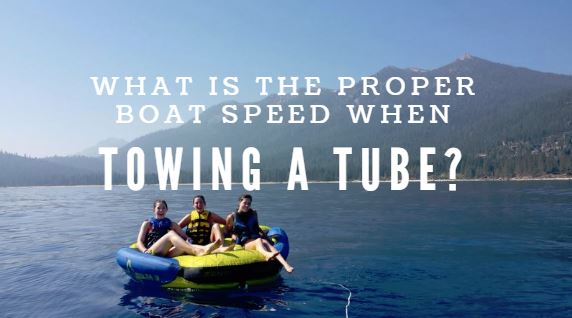
There’s no faster way to injure a friend or family member than to have a boat driver who has no experience behind the wheel when towing a tube. There are more injuries tubing than all other water sports combined. But it doesn’t have to be this way…check out these tips below to keep your family safe and have a fun day out on the lake!
Towing A Tuber Safely
When it comes to fun on the water, few activities are more inclusive than towing a tuber behind your boat. It’s fun for all ages, can be done behind just about any style of powerboat, and is straightforward to hook up. While much of this may seem like commonsense to those of us who grew up with watersports, a litany of high-profile accidents last summer has thrust watersports safety into the spotlight. One state, Illinois, passed a new law requiring skier-down flags aboard boats, while others have proposed increasing criminal penalties for negligent operators.
Keep Your Distance:
The most important thing to remember when towing anyone behind the boat, whether on skis, a wakeboard, or on a tube, is to keep a safe distance from both fixed objects like docks, channel markers, bulkheads, or shorelines — and from shallow water on BOTH sides of the boat. While ropes made for towing tubers are sometimes shorter, a full-length ski rope measures 75 feet long — add another few feet to account for any yoke, or tow bridle, plus the length of the tube itself, and it’s best to consider 100 feet as a bare minimum safe distance. A tumbling tuber ejected from his or her ride will often travel an impressive distance above or on top of the water, so more room is safer. If you imagine a swath of water 300 feet wide (the length of a football field) with the boat at the center as your “safe zone,” then steer to prevent anything from entering that zone, you’ll be off to a good start. Keep in mind that tubers, more than skiers or wakeboarders, are at the mercy of the driver, because they can’t steer the tube, or release the line.
Speed Is Critical:
If you’ve ever experienced the exhilaration of being whipped through a tight turn at the end of a ski rope, you know firsthand that the tube absolutely hums along, skipping lightly across the water. But it may surprise you to know just how much faster the tube is traveling than the boat. The key to this is the length of the ski rope, which puts the tube through a much longer arc than the boat itself travels. In a full turn, particularly a tight one, the tube may travel twice the distance of the boat, which means it’s travelling twice as fast as well. So while you, the skipper, may be experiencing that turn at a sedate 20 mph, your rider feels the water rushing by at 40 mph or more — making it doubly important to avoid those aforementioned solid objects.
- When towing young kids on tubes, keep the speed between 8 and 12 MPH. The younger the age, the slower the speed.
- When towing teenagers/adults on tubes, keep the speed from 15 to 20 MPH.
Be Aware Of Other Boats:
Other than striking a dock or piling, perhaps the greatest danger to a tuber is other boats, particularly after a rider falls off the tube. Unlike skiing, tubing doesn’t require flat water, so you often see tubers in more crowded waters. It can be difficult to see someone bobbing in the water waiting to be picked up, even if the tuber is wearing a brightly colored life jacket. Other boaters don’t expect swimmers away from shore where you’re likely to be towing, and they can easily fail to spot a head just above water. Skiers and wakeboarders are taught to hold the ski or board up out of the water to increase visibility. Tubers don’t have this option. For this reason, some states require boaters to display an orange flag on the boat when a rider is down in the water.
To increase the safety of your tubers, avoid towing in congested areas, busy channels, and the like, and pay attention to other boats in the area. Their operators may not be watching you or paying attention to the erratic movements you’re making while trying to give your tuber a thrilling ride. Your spotter, a second adult in the boat responsible for keeping an eye on the rider, will allow you to focus on driving, and not the rider.
Stay safe and have fun!
Posted by Scott Freerksen “The Lake Guy”
